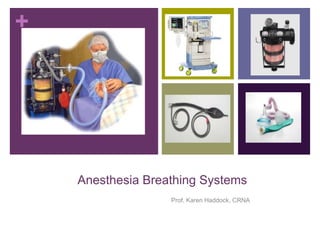Anesthesia breathing systems are used to deliver anesthetic gases and oxygen during anesthesia. They aim to deliver gases with minimal increase in airway resistance while offering a safe and convenient method of delivery. All systems have two purposes - delivery of oxygen/gases and elimination of carbon dioxide. Systems are typically classified as open, semi-open, semi-closed, or closed based on the presence of a gas reservoir bag, ability to rebreathe gases, means of neutralizing carbon dioxide, and presence of unidirectional valves. Common semi-open systems include various Mapleson circuits like the Bain circuit, while semi-closed systems incorporate a carbon dioxide absorber and three-way valves, like the circle system.




















































